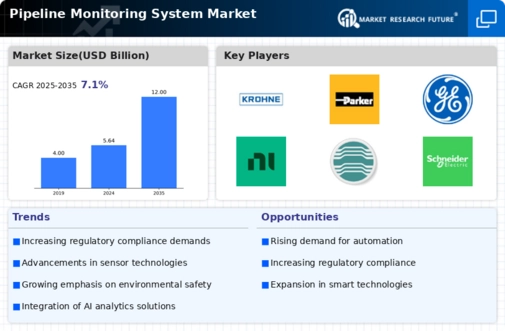Top Industry Leaders in the Pipeline Monitoring System Market

*Disclaimer: List of key companies in no particular order
The pipeline monitoring system (PMS) market is undergoing a period of dynamic growth, driven by escalating concerns regarding leaks, stringent regulatory measures, and technological innovations. To gain insight into the competitive landscape of this thriving market, a closer examination of key player strategies, market share influencers, emerging trends, and the overall competitive scenario is imperative.
Key Player Strategies: In navigating the competitive landscape, understanding the strategies employed by key players is paramount. ABB (Switzerland), Emerson (US), Honeywell International (US), Schneider Electric (France), Siemens AG (India), Badger Meter (US), Bentek Systems Ltd. (Canada), General Electric (US), Hollysys Automation Technologies (China), and Inductive Automation (US) are pivotal entities shaping the industry.
Market Share Analysis Factors: Several factors play a pivotal role in determining market share within the PMS domain. Geographical footprint stands out, with companies boasting a robust global presence and established distribution networks enjoying a competitive advantage. Notable regional leaders like Yokogawa in Asia and Krohne in Europe cater to specific market needs. The breadth of a company's product portfolio is also crucial, and industry giants like Siemens, offering comprehensive solutions spanning leak detection, flow monitoring, and corrosion prevention, attract a broader customer base.
Customer service and support play a pivotal role in retaining clients within the PMS market. Honeywell's global network of service centers and Emerson's remote diagnostic capabilities are shining examples of robust customer support strategies. Additionally, pricing strategies come into play, with cost-effective solutions gaining favor in emerging markets. Chinese companies like Zhejiang Sanhua Instrument and Shanghai Meters & Instruments have garnered traction by offering competitively priced solutions in budget-sensitive regions.
New and Emerging Trends: As the PMS market evolves, new trends are shaping its trajectory. The integration of the Internet of Things (IoT) and big data analytics is a prominent development, enabling real-time data collection and analysis. ABB, for instance, is actively developing cloud-based platforms for data visualization and advanced analytics.
Drone-based inspections are gaining prominence due to their efficiency and enhanced safety features. Belgian company Flyability has pioneered autonomous drones specifically designed for pipeline inspections in remote or hazardous environments.
Cybersecurity has emerged as a top priority, given the increased reliance on cloud-based PMS solutions. Companies such as Dragos and Claroty specialize in offering cybersecurity solutions tailored for industrial control systems, including pipeline infrastructure.
Sustainability-driven trends involve the adoption of eco-friendly materials like bioplastics in pipelines and the utilization of solar-powered sensors. Enviva is actively developing bio-based pipeline solutions, while Siemens is offering solar-powered pipeline monitoring systems.
Overall Competitive Scenario: The PMS market is characterized by intense competition, featuring a mix of established players and innovative startups. Continuous technological advancements, heightened awareness of safety and environmental concerns, and the escalating demand from emerging markets will continue to propel market growth. Companies that adeptly adapt to these evolving trends, invest in research and development, and provide comprehensive solutions coupled with robust customer support are poised to secure market share and thrive in this dynamic landscape.
It is crucial to note that the information provided is sourced from various outlets and is accurate as of December 15, 2023. Staying abreast of the latest developments in the PMS market through company press releases, industry reports, and relevant news articles is essential for stakeholders seeking to remain informed and make strategic decisions.









